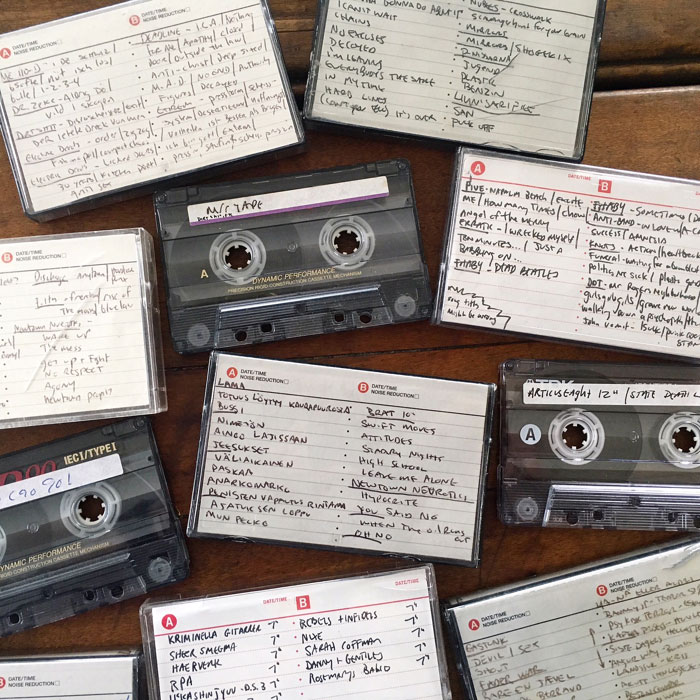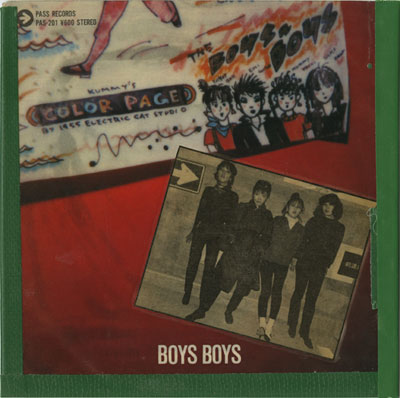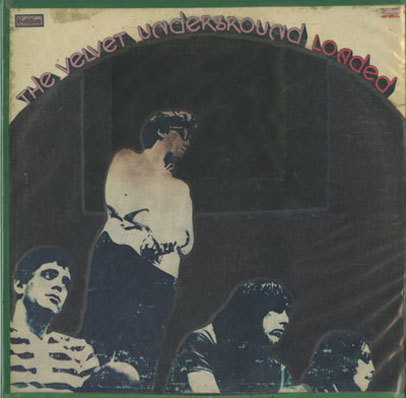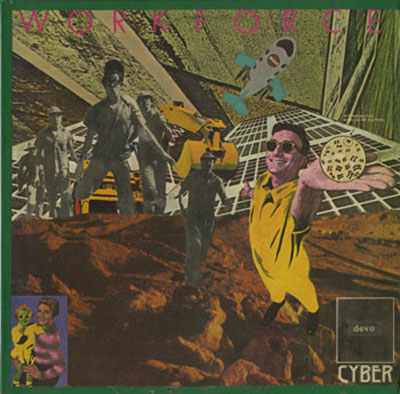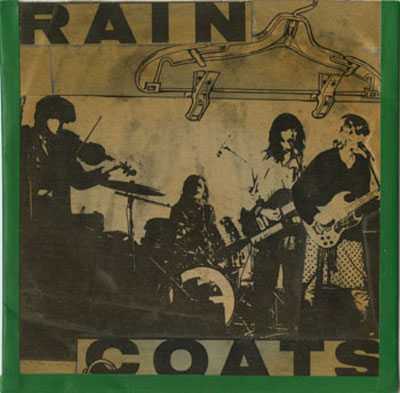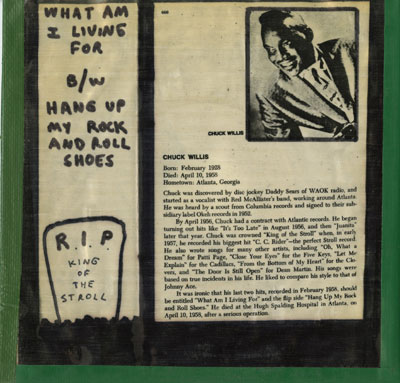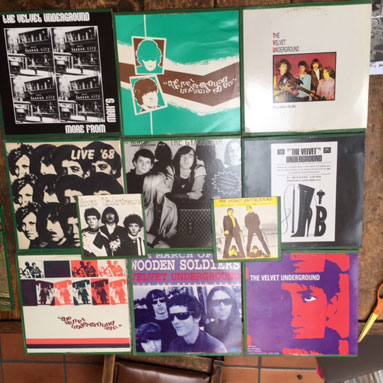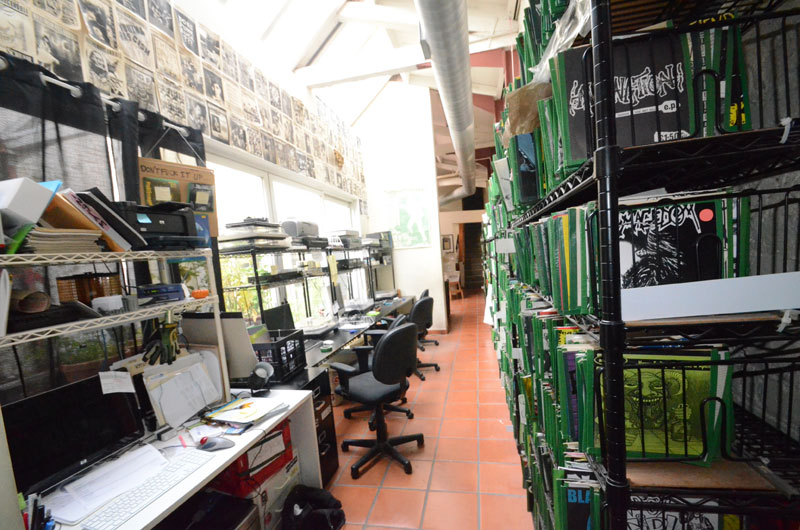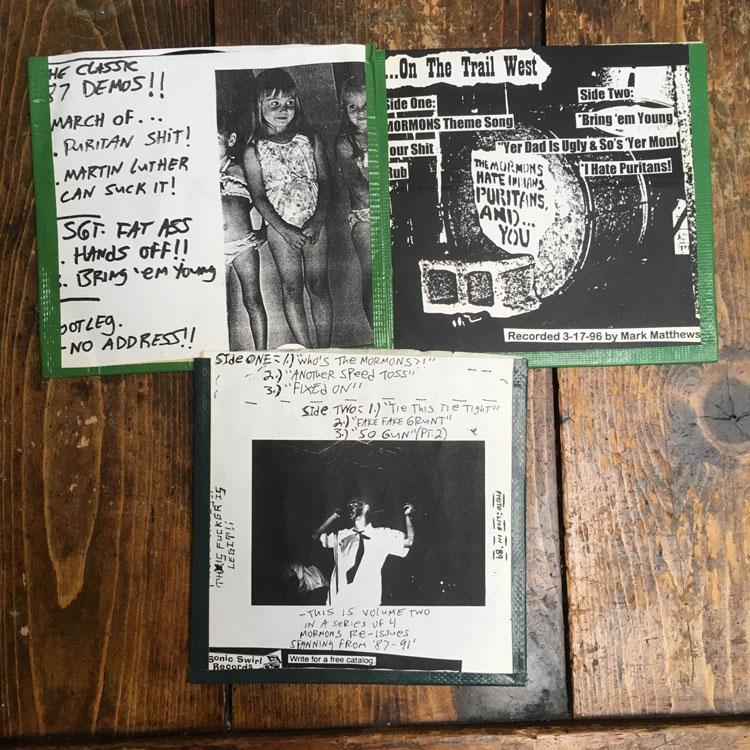TB: It occurs to me that I might not be the greatest person to conduct this interview because I have so many questions about specific, trivial, totally fucking awesome aspects of this project that I am tempted to zone in on� but I should probably aim a little broader to start. I think most people who've identified as punks at any point post-Reagan probably know Maximum Rocknroll the monthly zine but there really is so much more than that. Can you give an overview of MRR and talk a bit about not just the magazine but some of the other aspects of the wider MRR umbrella?
GMA: Maximum Rocknroll is and has been a fanzine, a record label, a radio show, a community space, an angel investor, a bailer-out-of-jailer, a distributor, a book publisher, a show promoter, a punk house, a crash pad, a record collection, a photo archive, a radical history repository, a research center, a thorn in the post office�s side� the list goes on. As coordinator I am the building manager, the accountant, the editor, the publisher, the proofreader, the ads department, the janitor, the HR person...It�s a long-running social experiment�what happens when you put four people to work, unpaid, in a building that is both their office and their house, give 100 other volunteers keys to the place, and entrust them with upholding nearly 40 years of fierce independence and paying rent in the most expensive city in America? The print magazine is the unit that we orbit (it sets the schedule and pays the bills) but there are lots of tendrils going in different directions.
The front page of the magazine says: �Maximum Rocknroll is a monthly publication. All work is donated and no one receives any salary. All proceeds are either invested in technological improvements or go to other similarly not-for-profit projects.� In the course of its history, MRR has invested in punk projects all over the world, from sending $100 to a zinester to help them keep their publication in print, to providing nearly 100% of the start-up capital of a place like 924 Gilman. It�s in that spirit that we�re launching the archive project, investing in a globally accessible resource that will benefit punks of all kinds all over the world.
TB: I have a xerox of a letter that MRR�s founder, Tim Yohannan, sent to a Southern California record store in the spring of 1977 where his early fervor for obtaining punk records is evident. And by all accounts, this passion was limitless and carried through the rest of his life. This must be, literally, the most expansive historical document of international punk, right?
SW: I can�t imagine what would be larger or more expansive. It�s 48,870 records, as of this writing, and we�ll likely top 49,000 by the time this is posted. We have hundreds of demo tapes (The Wrecks! The Psychos!), photos, zines, letters, postcards, and books. We have a Chung King. We have a Terveet Kadet test press that never came out. We have tapes that I believe were the OG source for some of the songs on Not So Quiet on the Western Front.
It�s very humbling to think about the scope of the collection and how it came to be�people all over the world believed in the vision of the magazine, or they just wanted to get their record reviewed, or Tim wrote to them and they responded and sent something in. I�ve been inventorying early hardcore demos the past few days, and they encompass so much more than the canon. There�s so much shit I want to listen to! We are having a preservation assessment and digitization done by an audio archivist and engineer who is generously donating her time and expertise, and afterward I�m making a mixtape of tape-only one hit wonders (from preservation-quality digital audio, natch).
It�s a huge collection, but it�s been heavily purged over the years, and it�s missing a lot because of the way we acquire records. Everything that gets sent in for review gets added to the permanent collection, but we have had limited funds to buy records that don�t get sent in, not to mention all the records that just don�t cross the coordinators� radars. Really, there are probably hundreds of bands and labels who just hate MRR and won�t send in their record, for whatever reason. There is punk music being made all over the world that will never see a vinyl release, and we don�t have the space to keep cassettes or the capacity (or desire) to review digital-only releases. I like to think of the record collection as part of an institutional archive, reflecting the history of the magazine instead of punk as a whole. The two are invariably linked, though, and you�d be hard pressed to imagine a punk present without MRR and its consistent coverage of the worldwide punk underground.
TB: Can you talk about the current state of the archive, what your goals are for its future one, five, ten years down the road? What are the challenges that lie ahead in the preservation efforts? How did you come aboard in your role as Archive Coordinator?
SW: I�ve been working in libraries and archives for the past decade, and I had been working as an interlibrary loan librarian at a large historical organization when becoming the Archive Coordinator crossed my radar. Grace was in Minneapolis visiting her brother, and we met up for records, bullshitting, and strawberries one disgustingly hot day. She mentioned that the archive project was a priority once the magazine was in a financial position to support such a project, and I said that I was interested. I spoke at length with Grace and other shitworkers to come up with a plan for the archive project, and after board approval, I moved out here from Minneapolis in April.
I had only been to MRR once before, but I had an idea of some challenges ahead of me from trying to pull an LP off the shelf. If you�ve never done that, it�s like getting a bug off of flypaper. I like the concept of green tape�devaluing records and making them into a community resource, making them all the same, bringing exalted rarities down to earth�but it can be damaging to records. We have so, so many LPs crammed together on wire shelves. When people try to reshelve records, the bottom tape can get smushed and the paper on the cover can tear. The 7�s were all rehoused in boxes a few years ago, which has been a huge help, and putting poly bags on LPs should drastically and quickly improve the situation. The worst part to me is that we green tape poster sleeves. None of our Crass Records stuff folds out! It�s insane. So many song titles, label names, subtleties in the art, all covered up by green tape. That said, the collection has been shepherded through the ages by a series of dedicated shitworkers and coordinators who are always stretched thin in other ways, so it really is remarkable how organized it is.
GMA: The archive is plagued by two things that plague almost every radical institution: not enough person power and not enough space. It�s an archivist�s nightmare insofar as anything adhesive is an archivist�s nightmare, sure (how many rolls of green duct tape have we gone through throughout the years?) but the green tape�s been there since long before the magazine. The logic of an archive is just as important as the objects in it�they give each other meaning. The collection started as someone�s personal record collection and it�s important to remember that. It�s sometimes frustrating that you can�t fold out a Crass sleeve, but it�s also refreshingly democratic�the objects are not and have never been treated as precious. They were all treated the same and that�s what�s so great about MRR. Just like we review every record that comes in that fits our parameters, and just like those reviews are all published in the exact same size font. I think about the records that Tim so gleefully made new cover art for�I can�t imagine anyone I know making collages and then laminating their LPs. That adhesive�s �bad� for the records also but it�s a very vivid example of what made him so special. That fervor and passion is what made this collection even possible. The records have needed attention for a long time, but they aren�t water damaged, they aren�t moldy, they aren�t warped. You almost never pull something off the shelf where the vinyl is beat to death. It�s not a pristine library, but it�s a functional one, and about to become infinitely more so with the work Shivaun is doing.
SW: The archive project is going to roll out in a few phases. We will be launching the database in early 2017. It�ll have every record review, discography information for every record in our collection and many others that have been purged, and digitized copies of every issue of the magazine. The next year will be a time of intense, often tedious work. I�m inventorying, cleaning, rehousing, and adding discographical information for every single record in the collection. I�m not excited about doing this for 50 Electric Frankenstein records, but one of the first records I found when I got here was the Roodwitzwart comp LP (Cycling Dinosaur Records(!), Netherlands, 1984), and Jetset�s 22 tracks of tuneless thrash blew my brain open. There�s so much incredible music in there.
(Ed.: go to Discogs and check out the logo for Cycling Dinosaur Records immediately!)
I have big visions for phase two projects, but they likely won�t see the light of day in the next year. We have a shitworker named Sam who is helping out with radio show archives, and I�m trying to track down the tapes that we�re missing so we can digitize them and make access to audio available online. My grand vision of the radio show archive has all the show tracklists tagged and each song linked to the record or tape it appeared on. This likely won�t happen for a long time. We want to make a mobile-friendly version of the database site. We want to make the whole database accessible for all users, and that means incorporating accessibility technologies. We want to get our zine collection�mostly zines with features on MRR � cataloged and discoverable online. My last job had incorporated a tool called Write on the Record into the library catalog so users could add information to individual catalog records without changing the metadata, and I�d like to figure out how to incorporate a similar tool to fill in gaps.
We joke about how the archive and database will be the ultimate toilet time-waster, and it will be, but the archive project is much more than that. I�m happy to be the reference librarian while I�m here and help someone find the Slaughter House �From the Dust Box� 8� flexi with only a few sketchy clues, but MRR doesn�t have the people power to sustain research like that. The project will make our collection something concrete, not mere legend. Plenty of people have come here to do research or stay here on tour, but they�re only seeing a small chunk of it. The collection needs to be fully cataloged with accurate metadata, and it needs to be adaptable and easy-to-use from a back end perspective so the work can continue when I�m not around.
TB: Well, you are my new worst friend for introducing me to the phrase �ultimate toilet time-waster.� Anyway� Roodwitzwart added to my want list. Please continue to loop me in on under the radar gems that you discover! Years ago, I was flipping through 7�s at MRR and stopped at the Boys Boys single because the cover looked cool. Then saw it was on Pass Records, the Japanese label who released Friction and Tsunematsu Masatoshi, and threw it on the turntable, where it stayed for much of my visit. I am sure everyone gets in a loop where they listen to the same things on repeat but discoveries like that�which are limitless with this collection�are nice reminders that there is so much amazing music out there.
|
TB:You�ve both touched on some of the things that I find fascinating about the collection and I want to dig in on. This record collection did not begin as a museum, these were Tim�s records. And Tim had an atypical relationship with these objects. It has been my understanding that, in a time before punk existed (Rutgers College, ~1965) Tim was finding his roommates would walk off with his records and needed a defense mechanism, so he lined the outer perimeter of each sleeve with green duct tape. It�s such an interesting solution�ugly, irreversible, completely changes the object. I suppose he couldn�t have thought this through when he began, but it must add a substantial volume/weight to the shelves, too! So my question is: how tight are you all with the green tape company?! I often wonder if Tim had a sense of humor about spending time and money to track down a banger only to destroy it with green tape once he finally has it in hand. And if he is laughing from punk rock heaven at the preservation challenges caused by 50 years of records stuck together by pressure and green duct tape.
SW: I know you�re joking, but I did the rough math and we order 48 60-yard rolls of tape each year from Bron Tapes. The green tape is not just a preservation challenge, it�s an accessibility challenge too! I don�t think Tim had envisioned his collection being this large and not being purged every so often. Since his death, there hasn�t been a purge and bands have put out way, way more records, and we�re at full capacity. I�m very excited to get a new LP shelf, personally.
A few years ago, someone donated United Blood to replace our stolen copy, and I just found it in an envelope in the safe, untaped. We joked about auctioning off the chance to cut open the top and green tape it to benefit the archive project, but realistically a lucky shitworker will get to do the honors.
GMA: I think the real story is that Tim went to Mexico in 1966 and there was a band in DF that he hung out with. The singer of that band taped his records and Tim stole the idea from him because he thought the records looked cool. At the time, he only had a few dozen LPs. There�s an interview with him somewhere where he says something like, �If I had known I never would have started��
Jeff Bale, who was involved in the founding of the magazine and was the architect of the record reviews section, hated the green tape. HATED and was vocal about it. From what I know of Tim, he was a pretty stubborn guy, so I�m sure Jeff�s ire only fueled his commitment to the practice!
TB: The other, brilliant Tim Yo move was that if he didn�t like a record�s artwork, or if he liked a record that didn�t have artwork, he�d make his own! There are so many awesome examples and range from simple punch-ups where he�d laminate a band photo over the existing sleeve to full-on collages. What are some of your favorites? How many of these sleeves did he make? Do you know if any other shitworkers made their own sleeves at any point or was this exclusively a Tim activity? At what point did he stop doing this? What�s the most recent record with a Tim Yo sleeve? Also, is there any documentation or even lore (interviews, writing, conversations remembered) with Tim talking about these sleeves?
SW: I don�t know of any documentation of Tim talking about the sleeves, nor of any other shitworker making a custom sleeve that has been retained in the collection, but I�m new here. We have approximately 280 custom 7� sleeves and 60 custom LP sleeves, with possibly many more lurking in the collection that I missed in my informal census. The most recent one I�ve seen is a Big Black bootleg 7� from the late 80s. One of my personal favorites is the Workforce of the World live bootleg LP sleeve. Tim enhanced it with black and white photos of Devo popping up over the extraterrestrial horizon and helpfully relabeled the LP so everyone knew it was actually Devo. It looks completely natural! So many of the covers do�you would have no idea unless you knew what you were looking for. He often made sleeves for soul and early rock�n�roll singles without picture sleeves, and he later did this for punk records without picture sleeves. We have at least two Go-Go�s bootlegs with very colorful covers of the band members.
I�m mentally inventorying the bonzer bunker right now trying to think of more. Tim is infamous for his hatred of Raymond Pettibon�s art, and we have Nervous Breakdown with a custom cover. We have Heart Attack God Is Dead with a photo of the band waxed onto the cover. Tim made a cover for the Lizerds 7� with a lizard (or snake) skin background. I love seeing these KBD records with custom art, and I�m excited for the inventory stage of this project, after which we�ll have hard numbers on the intersection of the bonzer bunker and Tim�s artistic proclivities!
GMA: I�ve told this story a bunch of times before, but the first night I spent alone in the house, I was feeling homesick and pulling old favorites off the shelf and I kept pulling down handmade sleeves: Raincoats, Neo Boys, Teddy and the Frat Girls, Siouxsie, Devo� We have thousands of records here and only a tiny tiny fraction of them have these handmade sleeves� Don�t tell me you don�t believe in ghosts.
|
TB: I am curious about Tim�s record purges. He would periodically get rid of parts of the collection with sometimes surprising releases making their way out of the collection. I have assumed that these were mostly done to draw a line in the genre�known purged items include things on the post-punk and metal side of the fence. What criteria was used when purging records? Was quality ever a consideration or did shitty punk records get kept while brilliant post-punk got nixed? What are some of the most surprising records that were purged?
GMA: There were two major purges. One came at the end of 1993 and beginning of 1994. In issue #129 of the mag Tim wrote, �A few notes about what you WON�T find reviewed in these pages. You won�t find major label releases, nor their phony subsidiaries, no will you find releases produced and distributed by Caroline or Relativity, who are also up to their necks in major label connections. You also won�t find a lot of releases from big indie labels that used to be known as �punk� labels but are turning out the most dreadful rock imaginable. As a rule, you�ll find less and less emo, metal, post-hardcore and pop being reviewed, as those genres seem to be veering further and further from their rock & roll roots and towards all the egotistical self-indulgences of early 70s hard rock. Generally speaking, if it ain�t reviewed here, it�s not because we never got the record...and more than likely it�s not being reviewed because it has absolutely nothing to do with punk or hardcore and sucks big time.� It was announced at the year-end shitworker meeting, the same meeting where he fired Jeff Bale. The former caused more of a stir. It tightened up what was allowed in moving forward, but Tim did go back through the collection and get rid of things that didn�t fit his new definition of acceptable.
The second purge came just before his death. People say that he�d pick a whole shelf of records and go through and randomly needle drop on each of them. If what he heard didn�t sound punk, out it went. Quality wasn�t a consideration of what was kept�and never has been. We have a lot of chud, ha! I think Minutemen, some Big Boys, Raincoats records all got purged� indisputably punk classics, in my opinion! Plus all the emo and late Dischord stuff. We had a shitworker over the other day who was very sad that we didn�t have any Saetia records on the shelf...
TB: Is there any desire to get some of this stuff back�if not the exact purged records then some of those titles? This makes me think of one more thing� In addition to purges, I am sure there have been records to disappear�stolen, broken, otherwise unaccounted for. Add in plenty of new discoveries and other records that Tim was never able to track down in the first place. Since his death, has the magazine had the ability to actively seek out records (non-new, non-reviewable) to add to the collection? (I would also imagine that having a viewable database would allow a transparent platform for punk philanthropists to see gaps and help fill them!)
GMA: Every once in awhile, I will get a green-taped record sent to me in the mail, that someone found in a dollar bin somewhere. Most recently, someone sent me the old MRR copy of the 3 LP on Dischord, along with an un-green-taped copy of the Meltdown LP. I wrote in a column one month about how we were missing both Meltdown records in the collection and both got donated. The LP was sent by someone involved in its release��We didn�t send it in for review because the review of the 7� said �avoid at all costs.��
We have printed want lists in the past and gotten some pretty rare records donated as a result � copies of In My Eyes (though we need a cover!) and United Blood, just to name a few. There are a few people in the world (mostly ex-coordinators) who are obsessed with filling the holes in the collection, not just of rare records that got stolen, but finding things that just never got sent in. One thing that the reviews database and subsequent inventory will show is what records we have a review for but no longer have on the shelf. Since reviews were tied to record acquisitions, this will more concretely reveal to us both what was purged by Tim and what may have been stolen over the years and will help us build a more complete and extensive wantlist.
In terms of acquiring records, filling all the holes from the past is just impossible. We spend most of our admittedly limited record budget on contemporary punk records, in our quest to keep new acquisitions as complete as possible. We comb through distros every month looking for things that don�t get sent in and write to labels to let them know why we think it�s important that they send us a copy or two. If we can�t convince someone to send us a copy, we�ll generally find a way to buy one.
With regard to theft: It�s likely that 100 people have a key to this house. Coordinators are usually home but there are lots of times when the collection is left unsupervised. We are never installing security cameras or anything like that�this is a magazine that has long been built on trust and it�s going to stay that way. We lock up the very rarest records in a safe behind my desk, but there are lots of bonzers in the wilds of our shelves, because they are meant to be accessible! It would be antithetical to the spirit of the collection to limit access to the collection any more than we have.
|
TB: Couple quick ones: Do you still have any paste-ups of original magazine layouts?
GMA: We don�t have any original paste-ups. As far as I understand, there used to be big layout parties on Sunday afternoons where people would get together and sit around the wooden table (that we still have!) and put the magazine together. Paul Curran actually got his start at MRR working on these layouts as a super young kid (he�d go on to be coordinator and still runs our website to this day). His parents were graphic designers so he knew his way around X-Acto knives and waxers even as a teenager. Tim put him to work the first time he walked into the house. We still have lots of the original photos that were mailed in by bands to be included in layouts with notes on the back about sizing etc for the printer, and we still have the waxer up in the crawlspace. The photo archive will go online in coming years too, after we finish our next big project � the MRR book!
The reason why MRR hasn�t been given the retrospective book treatment yet (like so many other fanzines) is the same reason why we don�t have a stack of paste-ups sitting around: we�ve never stopped being active. The magazine moves so quickly�finish one thing, on to the next, and the print magazine has always been the thing this whole operation is organized around. Why archive the paste-ups when you have the real thing right there? Elements had to be reused from month to month�make it up and disassemble it! Rip it up and start again...
TB: Although you have plenty of tapes, CDs, photos and zines on hand and in the archive, these weren't preserved as rigorously as the records. Why were these treated more ephemerally? Is the stuff on hand just the stuff that was really loved and kept or is it random?
GMA: Tim Yohannan was a record collector. Records were the most important thing in the world to him. That�s why we have 48,000 punk records instead of 48,000 tapes. Manic Hispanic put out a record that he loved, but only on CD. He wanted to own a vinyl copy of it so he paid for a short run of records. Undoubtedly, part of the reason Tim did the magazine was to get free records. He would say that himself!
The zines that were submitted to MRR were never archived in a formal way. The bulk of our zine collection comes from a few large donations over the past few years. The tapes that we have in the safe�many of them super rare�actually were in a box in Max Ward�s trunk for a long time until they made their way back home. The zines that we have now are being catalogued by a long-time shitworker, Heidi Booth. Once we have a sense of what we have we�ll make some decisions about what to keep and what to find more appropriate homes for. Like I mentioned above, we have a big photo archive. They were treated more ephemerally because of their context�they were in service of the magazine, so once they were used for a layout, maybe they found their way into a file, but more likely, they went to the trash.
|
TB:I am so excited for this project. Over the years, I have dreamt of infinite access to the MRR archives, and I am giddy that it's right around the virtual corner. No longer will I have to email the coordinator to get a list of what Velvet Underground bootlegs were in the collection, I'll have that at my fingertips!
The ability to view every issue of the magazine, read every review, listen to or see tracklists of old radio shows, view early fliers (some of the early MRR Radio color xerox fliers are out of this world!) for free and on demand will make this the most important resource of first hand material available for this subculture. Empirical data for future scholars to rewrite some of the boneheaded narratives about punk that persist, proof of existence for wantlist mysteries, hope for younger generations that � holy shit! a band from my town put out a record in 1983? � and so on.
GMA: Yes! This! Golnar Nikpour, former coordinator wrote this in an email to me the other day, and I can�t say it better myself: �Crucially, MRR is not only (by far!) the biggest archive of its kind but the most global�it features countless rare and priceless records from every continent on Earth (sans Antarctica), almost 100 countries total. Let that sink in for a second�autonomously produced and underground (mostly) youth culture from nearly one hundred countries all housed in one breathtaking archive in an unassuming brick building in the center of San Francisco. This is the place to be if you care about Cambodian garage rock or Swedish girl bands or Brazilian thrash or Turkish post-punk or Italian anarchist publications or Filipino teenagers making anti-state pogo punk or whatever else you can think of.� I can�t wait till we make that discoverable and accessible to everyone who can�t come see us at the house. Youtube was a great leveler in punk over the past few years�instant access through a quick couple searches. This is going to make that kind of exploration easier and more expansive, give it so much more context.
TB: Which leaves me with the most important question, how can someone help out with the MRR Archive project?
SW: Financial help is huge for us. We have a fundraiser up until June 17 with rewards like shirts, pins, stickers, prints, tote bags, and rare records. Labels have been extremely generous with test presses, which we�ve been putting up every week. There�s an Anti-Cimex EP box set up right now! Here�s a link. We can accept tax-deductible donations year round. If you choose that route, please note that it�s for the archive project.
I�ve been coordinating distance volunteers doing transcription work, and I always need more people to help out with that. Bay Area people can get their hands dirty in the collection and help out with rehousing and inventory. I�m looking for old MRR Radio tapes, too, and I�ll be posting a list online with what we have and what we need. I�ll be making a massive poly bag and paper inner sleeve order after the fundraiser, but if any labels have extra supplies lying around, we will take them. If you run a label and haven�t sent in your records for review, please do! They become a part of the collection and database forever.
I�m always happy to talk to librarians and archivists about ideas for this project. Get in touch: [email protected].
END INTERVIEW
APPENDIX:
Ed: Here we have yet another example of the incredible artifacts available via the MRR collection, this one of particular interest to Cleve-o-philes such as Dave and myself. As noted in the Dismantled Cleveland Discography section of No Stages , The Mormons 7" (recently comped on the 'Destroy All Art' LP) was submitted to MRR at least three different times over the years, with different artwork and song titles. As Dave notes "It always got good reviews", and once the MRR Archive is up and running we'll be able to read those reviews. Go donate now!
|



